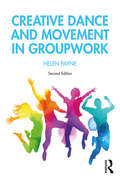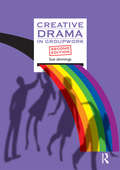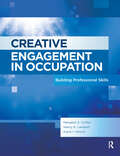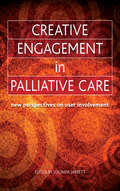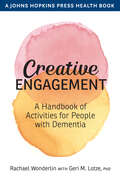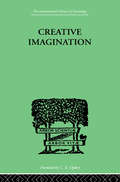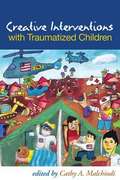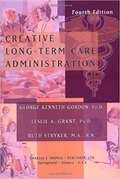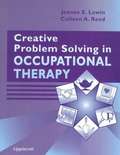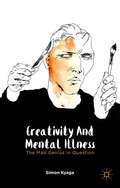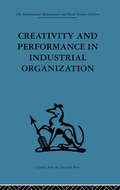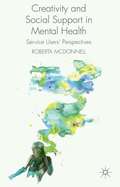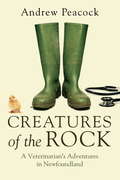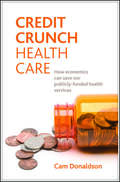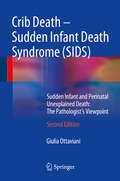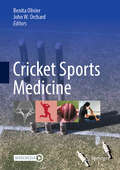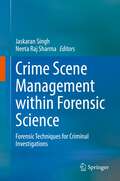- Table View
- List View
Creative Compassion, Literature and Animal Welfare (The Palgrave Macmillan Animal Ethics Series)
by Michael J. GilmourThis book examines animal welfare themes in fiction, and considers how authors of the last two centuries undermine dominative attitudes toward the nonhuman. Appearing alongside the emerging humane movements of the nineteenth century and beyond is a kind of storytelling sympathetic to protectionist efforts well-described as a literature of protest. Compassion-inclined tales like the Dolittle adventures by Hugh Lofting educate readers on a wide range of ethical questions, empathize with the vulnerable, and envision peaceful coexistence with other species. Memorable characters like Black Beauty and Beautiful Joe, Ivan the gorilla and Louis the trumpeter swan, Hazel and Cheeta, Mr. Bultitude and Doctor Rat do not merely amuse. They are voices from the margins who speak with moral urgency to those with ears to hear. This broad survey of ethical themes in animal fiction highlights the unique contributions creative writers make toward animal welfare efforts.
Creative Dance and Movement in Groupwork (Creative Activities in Groupwork)
by Helen PayneThis invaluable resource for teachers and therapists continues to explore the link between movement and emotions presented in the first edition of this innovative book. It provides 180 practical activities with a clear rationale for the use of creative dance and movement to enrich therapy or educational programmes. This book features session plans divided into warm-ups, introductions to themes, development of themes and warm-downs and explores many areas, including developmental movement processes, non-verbal communication, and expression communication. In addition to thoroughly updating the content of the original edition, this timely sourcebook includes new material on creative dance and dance movement psychotherapy, added references throughout and updated resources to reflect the most current knowledge. Creative Dance and Movement in Groupwork will be an invaluable asset for group leaders wishing to enhance their practice, as well as a starting point for those wishing to learn more about the field. It provides guidance and practical information that is suitable for working with clients of all ages and for those with a professional or practical interest in the educational, health, recreational or psychotherapeutic use of the arts, this book may act as one of many guiding lights on your journey.
Creative Drama in Groupwork (Creative Activities In Groupwork Ser.)
by Sue JenningsThis bestselling book is now updated with new material and more tried-and-tested ideas, bringing it up-to-date with contemporary drama. 150 ideas for drama in one practical manual makes this a veritable treasure trove which will inspire everyone to run drama sessions creatively, enjoyably and effectively. This book features advice on setting up a group, defining and negotiating aims and objectives, and how to ensure a successful session. It contains activities which encourage memory, interaction, concentration, feedback, and many other skills. It also includes games, warm-ups and starters, improvisation role-play, visual dynamics, and closures.
Creative Engagement in Occupation: Building Professional Skills
by Margaret Coffey Nancy Lamport Gayle HerschIn occupational therapy, creative thinking and problem-solving skills are critical aspects of delivering appropriate intervention programs. These professional characteristics are essential components in the clinical reasoning process that facilitate meaningful therapy.Creative Engagement in Occupation: Building Professional Skills is a comprehensive text on the recognition and development of creative thinking as a primary tool in occupational therapy.Margaret S. Coffey, Nancy K. Lamport, Gayle I. Hersch, and their contributors, guide occupational therapy students and clinicians in identifying their creative potential for designing activities to address client goals. By actively engaging in the creative process, readers can enlist the creative potential of their clients to overcome or compensate for limitations in occupational performance.The skillful application of activity analysis is advanced through the reader’s use of their own creativity in developing meaningful intervention programs for clients. References to the AOTA’s Occupational Therapy Practice Framework further support this aspect of the text as readers begin to sense and use their own and the client’s creativity in developing collaborative therapist-client partnerships.Experience these creative opportunities inside Creative Engagement in Occupation: Building Professional Skills through the use of case studies, discussion and individual activities, role playing, and worksheets. Each chapter offers didactic and experiential applications to develop and practice using creativity as it applies to occupational therapy practice.Included with the text are online supplemental materials for faculty use in the classroom. Creative Engagement in Occupation: Building Professional Skills offers a unique opportunity for occupational therapy students, faculty, and clinicians to develop their potential in delivering creative occupational therapy intervention.
Creative Engagement in Palliative Care: New Perspectives on User Involvement (Radcliffe Ser.)
by Lucinda Jarrett Sunderarajan JayaramanThis book offers an extensive range of ideas and practical developing service users' creativity including songmaking, drama, dance, creative writing, music, video and visual arts. It promotes innovation and encourages a fresh and enthusiastic approach to care that will appeal to anyone with a love of creative arts as a means of expression. The wide-ranging approach encompasses many different voices from patients, artists and healthcare professionals. "Creative Engagement in Palliative Care" is highly recommended for all palliative health and social care professionals and volunteers, including occupational therapists, and art and music therapists. It is a wonderful resource for health and social care educators, teachers and trainers and will be a immense source of inspiration for patients and their families.'This book is about user involvement. It is concerned with sharing knowledge and experience about user involvement in palliative care and making it more real for the future. In modern times, the importance of 'end of life care' was highlighted by the pioneers of the voluntary hospice movement. They emphasised the importance of palliative care being based on an holistic approach that took account of all aspects of people's lives and deaths; medical, social, spiritual and material. More recently the work of the independent hospice movement has been complemented by the development and expansion of specialist palliative care in state provision. The aim has been to enable people to be able to 'do it their way' with a real sense of control and to be able to communicate their unique words, voices and experience. This is and will always be a key potential of user involvement.' - Suzy Croft and Peter Beresford, in the Preface.
Creative Engagement: A Handbook of Activities for People with Dementia (A Johns Hopkins Press Health Book)
by Rachael WonderlinWhether they are cared for at home or in an assisted living community, adults living with dementia should be offered a life that is interesting and fun. But what can you do to enhance the everyday experience of a loved one who is losing interest in or is unable to participate in their old hobbies and pursuits? In Creative Engagement, dementia activity expert Rachael Wonderlin and developmental psychology professor Geri M. Lotze provide dozens of creative, hands-on ways to engage with people living with cognitive loss. Teaching caregivers how to find dementia-friendly daily activities and introduce them into a person's life, this comprehensive, empathetic guide is aimed at both family members and professionals. Twelve chapters full of useful, tangible activities touch on a range of topics, including exercise, technology, cooking and baking, memory games, and arts and crafts. Focusing on both group and individual dynamics, mundane activities and specially tailored pursuits, Wonderlin and Lotze offer proven strategies for interacting with people living with dementia. The authors include detailed tips for building a dementia-friendly environment, creating a daily calendar, and scheduling community entertainment. They also suggest special activities geared toward people in hospice care and give targeted advice for dealing with caregiver stress.Drawing on Wonderlin's own practice while incorporating the latest scientific research on dementia and eldercare, Creative Engagement is unique in its dementia-positive approach. Anyone who cares for someone living with dementia will gain valuable knowledge from this compassionate book.
Creative Imagination: STUDIES IN THE PSYCHOLOGY OF LITERATURE
by Downey, June EFirst published in 1999. Routledge is an imprint of Taylor & Francis, an informa company.
Creative Interventions in Grief and Loss Therapy: When the Music Stops, a Dream Dies
by Thelma DuffeyGet the tools to help the grief that comes when a dream diesEvery person at one time or another suffers when his or her dreams are shattered. Creative Interventions in Grief and Loss Therapy: When the Music Stops, a Dream Dies provides truly innovative approaches to therapeutically help individuals work through and survive grief and loss. Leading experts explore creative interventions for common, yet emotionally devastating problems faced by those weathering the storms of grief after their dream has been destroyed. Therapists and counselors get the effective tools to creatively help people through the difficulties of dealing with death, addiction, trauma, changes in life circumstances, divorce, heartbreak, miscarriage, co-occurring mental health and substance use disorder (COD), suicide, adoption, and issues with children.The chapters in this innovative volume cite existing research on specific grief and loss issues and illustrate a clinical application for each situation using various creative mediums such as music, writing, or ritual. Each approach can be expanded and modified with care by clinicians of all types to better help clients through the process. This resource is extensively referenced.Topics in Creative Interventions in Grief and Loss Therapy include: how storytelling, journaling, and correspondence can be used to process the experience of a counselor’s loss following the death of their client using psychodrama and the utilization of empty chair techniques to address addiction related grief and loss the use of rituals as an intervention to help clients trauma and loss during times of natural disasters the process of gatekeeping by counselor educators Emotional Freedom Technique (EFT) as an approach to help student athletes deal with life after the sport a literary exercise to help clients work toward forgiveness after divorce using books, songs, and projects to assist clients experiencing grief after the death of their adolescent child creative strategies to aid clients through the grief and loss of love effective interventions to assist clients through loss from miscarriage using music, videography, visual arts, literature, drama, play, and altar-making in the grief process innovative interventions for individuals with co-occurring mental health and substance use disorder suicide high risk factors—and a Pre-suicide Preparation Plan that mental health practitioners can implement creative intervention for the client who is adopted using super heroes and science fiction therapeutic storytelling for children in grief Creative Interventions in Grief and Loss Therapy: When the Music Stops, a Dream Dies is a creative, reaffirming resource perfect for mental health professionals, therapists, counselors, social workers, educators, and students.
Creative Interventions with Traumatized Children
by Cathy MalchiodiRich with case material and artwork samples, this volume demonstrates a range of creative approaches for facilitating children's emotional reparation and recovery from trauma. Contributors include experienced practitioners of play, art, music, movement and drama therapies, bibliotherapy, and integrative therapies, who describe step-by-step strategies for working with individual children, families, and groups. The case-based format makes the book especially practical and user-friendly. Specific types of stressful experiences addressed include parental loss, child abuse, accidents, family violence, bullying, and mass trauma. Broader approaches to promoting resilience and preventing posttraumatic problems in children at risk are also presented.
Creative Interventions with Traumatized Children, Second Edition: Creative Arts And Play Therapy, Eds Malchiodi And Crenshaw (Creative Arts and Play Therapy)
by Bruce D. Perry Cathy A. MalchiodiA trusted, bestselling resource, this volume demonstrates a range of creative approaches for facilitating children's emotional reparation and recovery from trauma. Experts in play, art, music, movement, and drama therapy, as well as bibliotherapy, describe step-by-step strategies for working with children, families, and groups. Rich with case material and artwork, the book is both practical and user-friendly. Specific types of stressful experiences include parental loss, child abuse, family violence, bullying, and mass trauma. Important developments in neurobiology, self-regulation, and resilience and posttraumatic growth are highlighted in this substantial revision. New to This Edition: *Chapters on art therapy and EMDR, body maps and dissociation, sandtray play, resiliency-based movement therapy, work with clay, mindfulness, and stress reduction with music therapy. *Updated and expanded discussions of trauma-informed therapy and the neurobiological basis for creative interventions. *The chapter on mass violence has been extensively rewritten with new case material on the Sandy Hook school shooting. This e-book edition features 65 full-color illustrations. (Illustrations will appear in black and white on black-and-white e-readers).
Creative Long-Term Care Administration
by George Kenneth Gordon Leslie A. Grant Ruth Perin StrykerThe prior three editions of this book were extremely well received for use in undergraduate and graduate courses in long-term care administration, and they were also popular as fundamental resources with practitioners as well as for an array of other long-term care practitioners and professions, including housing managers, board members, teachers, students, administrators, owners, and health care professionals who are seeking new directions in the field. This, the fourth edition, has been extensively revised. There is, for example, the fundamental updating throughout to reflect structural and regulatory changes that have been occurring in the field as well as the introduction of recent research findings, evolving ideas, and new practices. In addition, there are new perspectives introduced by nine new chapter authors plus three entirely new chapters: monitoring clinical outcomes, spiritual care, and using information technology. The book is divided into six sections: The Evolution of Long-Term Care; Developing the Organization; Human Resource Management; Optimizing Health Care Outcomes; Creating a Supportive Living Environment; and Creating a Better Future. This new edition also has an additional author, Dr. Leslie Grant, whose seasoned scholarship and visionary leadership will provide important, additional insight for the reader. The ideas presented are intended to provide a better understanding of the long-term care environment and to suggest ways of applying interdisciplinary knowledge for the administrator in this setting.
Creative Problem Solving In Occupational Therapy
by Jeanne E. Lewin Colleen A. Reed<P>This interactive text/workbook uses a structured approach to creative problem-solving.<P> Illustrated with examples and clinical stories from the authors' experience, it is designed to teach the reader skills to effectively solve therapy-related problems. <P>A variety of learning tools include: reflective journal entries which relate learned material to personal experiences; thinking strategies and organizers, in order to help readers visualize the required mental strategies for problem-solving; mind mapping exercises that help release the free flow of ideas necessary in the data-gathering phase; crossword puzzles and word searches to give students practice using occupational therapy vocabulary; and case stories that illustrate how CPS can be used to master any challenging situation.
Creativity and Communication in Persons with Dementia
by Claire Craig John KillickProviding people with dementia with opportunities to engage in creative activity can play a crucial role in maintaining and enhancing communication, and in reinforcing personhood and identity. This thoughtful book describes how people with dementia, and the people who work with and care for them, can foster and develop a creative approach, and provides rich and varied ideas for creative activities. The authors explore the concept of creativity - what exactly it is, its particular relevance for people with dementia and how to get into the creative 'flow'. They introduce a range of creative art forms, including poetry and story-telling, collage, drama, music-making, photography, textiles and working with wood and metal, and suggest possibilities for employing them in a range of settings, and with people of all abilities. Consideration is given to the practicalities of facilitating such creative work, including how to organise and run sessions, how to involve people with dementia and their carers, and how to reflect upon the experience. Practice examples are included throughout the book, as well as the comments and observations of people with dementia, and many examples of the artwork and poetry the authors have created with people with dementia over the years. Brimming with ideas, suggestions and helpful guidance, this is an essential resource for all those who work with people with dementia, and an inspiring read for people with dementia and their families.
Creativity and Mental Illness: The Mad Genius in Question
by S. KyagaIs there really a thin line between madness and genius? This book provides a thorough review of the current state of knowledge on this age old idea, and presents new empirical research to put an end to this debate, but also to open up discussion about the implications of its findings.
Creativity and Performance in Industrial Organization
by Andrew CrosbyTavistock Press was established as a co-operative venture between the Tavistock Institute and Routledge & Kegan Paul (RKP) in the 1950s to produce a series of major contributions across the social sciences. This volume is part of a 2001 reissue of a selection of those important works which have since gone out of print, or are difficult to locate. Published by Routledge, 112 volumes in total are being brought together under the name The International Behavioural and Social Sciences Library: Classics from the Tavistock Press. Reproduced here in facsimile, this volume was originally published in 1968 and is available individually. The collection is also available in a number of themed mini-sets of between 5 and 13 volumes, or as a complete collection.
Creativity and Social Support in Mental Health
by Roberta McdonnellThis book weaves together service users' lived experiences of mental health recovery and ideas about how creative activities such as art, music, and creative reading and writing can promote it, particularly within social and community settings.
Creators of Intelligence: Industry secrets from AI leaders that you can easily apply to advance your data science career
by John K. Thompson Dr. Alex AnticGet your hands on the secret recipe for a rewarding career in data science from 18 AI leadersPurchase of the print or Kindle book includes a free PDF eBookKey FeaturesGain access to insights and expertise from data science leaders shared in one-on-one interviewsGet pragmatic advice on how to become a successful data scientist and data science leaderReceive guidance to overcome common pitfalls and challenges and ensure your projects' successBook DescriptionA Gartner prediction in 2018 led to numerous articles stating that "85% of AI and machine learning projects fail to deliver.” Although it's unclear whether a mass extinction event occurred for AI implementations at the end of 2022, the question remains: how can I ensure that my project delivers value and doesn't become a statistic? The demand for data scientists has only grown since 2015, when they were dubbed the new “rock stars” of business. But how can you become a data science rock star? As a new senior data leader, how can you build and manage a productive team? And what is the path to becoming a chief data officer? Creators of Intelligence is a collection of in-depth, one-on-one interviews where Dr. Alex Antic, a recognized data science leader, explores the answers to these questions and more with some of the world's leading data science leaders and CDOs. Interviews with: Cortnie Abercrombie, Edward Santow, Kshira Saagar, Charles Martin, Petar Velickovic, Kathleen Maley, Kirk Borne, Nikolaj Van Omme, Jason Tamara Widjaja, Jon Whittle, Althea Davis, Igor Halperin, Christina Stathopoulos, Angshuman Ghosh, Maria Milosavljevic, Dr. Meri Rosich, Dat Tran, and Stephane Doyen.What you will learnFind out where to start with AI ethics and how to evolve from frameworks to practiceDiscover tips on building and managing a data science teamReceive advice for organizations seeking to build or mature a data science capabilityStop beating your head against a brick wall – pick the environment that'll support your successRead stories from successful data leaders as they reflect on the successes and failures in data strategy developmentUnderstand how business areas can best work with data science teams to drive business valueWho this book is forThis book is for a wide range of audience, from people working in the data science industry through to data science leaders and chief data officers. This book will also cater to senior business leaders interested in learning how data and analytics are used to support decision-making in different domains and sectors. Students contemplating a career in artificial intelligence (AI) and the broader data sector will also find this book useful, along with anyone developing and delivering university-level education, including undergraduate, postgraduate, and executive programs.
Creatures of the Rock
by Andrew PeacockWhen you're the only veterinarian in an area that's 130 miles long and has a coast on either side, you never know what each new day might bring. A cow giving birth, a colicky horse, an aggressive lynx, caribou in need of pastures new, a polar bear in a bingo hall, a six-hundred-pound boar who won't like what you've been asked to do to him... The only constants for Andrew Peacock are his faithful dog and his passion for his work.When Andrew Peacock made the move from Ontario to Newfoundland, he thought he was kicking off his career as a newly qualified veterinarian with a brief adventure in a novel location. Turns out he was wrong about the duration --he is still in Newfoundland three decades later. But it has certainly been an adventure. A whole series of adventures.In his immense new practice - half the Avalon Peninsula - Andrew was the only vet for miles around, visiting patients (and their owners) on farms, in homes and zoos, and in the wild. A day's work could include anything from performing a Caesarian section on a cow in a blizzard, to pursuing a moose on the loose, to freeing a humpback whale from a trap designed for cod. And, on the human side, anything from trying to impress a surprisingly large audience of farmers with your first boar castration, to taking care of the distressed owners of a stricken cat, to discouraging farm hands from helping themselves to hypodermic needles. All this against the background of a domestic scene in which Andrew's wife Ingrid--also freshly qualified, as a "human doctor"--shares the adventure of making a new life, fitting in to a well-established community, and in due course of starting a family.Andrew Peacock is a born vet, devoted to the care of animals, and in constant wonder as an observer of their lives. Luckily for the rest of us, he is a born storyteller, too. Creatures of the Rock is a funny, thrilling, unflinching but ultimately heartwarming collection of tales about the connections between people and animals, and people with each other.From the Hardcover edition.
Credit crunch health care: How economics can save our publicly funded health services
by Cam DonaldsonWorld-leading health economist Cam Donaldson defends NHS-type systems on the same basis as their detractors: economic efficiency. However, protecting government funding of health care is not enough: scarcity has to be managed. Donaldson goes on to show how we can get more out of our systems by addressing issues of value for money. In particular, he demonstrates what has been achieved through health care reform but questions how much more this can deliver relative to getting serious about priority setting. The issues addressed in the book have global relevance and this accessible book will therefore appeal to the public, health professionals and health policy specialists.
Crew Resource Management für Führungskräfte im Gesundheitswesen (Erfolgskonzepte Praxis- & Krankenhaus-Management)
by Marcus Rall Sascha LangewandTypische Besonderheiten in der Medizin: Hochrisikobereich, Schichtdienst, Teamwork interdisziplinär. Dies erfordert eine klare, eindeutige, schnelle Kommunikation, die auch in Notfallsituationen funktionieren muss. Anhand der 15 CRM Leitsätze werden Möglichkeiten aufgezeigt, die Personalführung zu verbessern. In Kombination der Anwendung dieser Leitsätze werden folgende Kompetenzen gestärkt: Analyse- und Diagnosekompetenz: CRM basiertes fundiertes Verständnis kommunikativer Dynamiken in Organisationen des GesundheitswesensStärkung der Selbst- und Fremdwahrnehmung in der FührungsrolleFührungskompetenz: Verständnis und Praxis von Leadership im Sinne nachhaltiger Führung, Delegieren im „double loop“ zur Vermeidung von MissverständnissenManagementkompetenzen: Veränderung von Führungsstrukturen und Kommunikationswegen im GesundheitswesenKonfliktkompetenzen: Konfliktanalyse, Konfliktbearbeitung und Konfliktlösung mittels einfacher Methodiken, z.B. „10 Sekunden für 10 Minuten“ Zu den zahlreichen Anwendungsbereichen zählen: Gestaltung von Führungsprozessen, Personal- und Teamentwicklung, Innovationsmanagement und Strategieplanung, Organisationsentwicklung, Changemanagement, Konfliktmanagement – also tägliche Führungsarbeit.
Crib Death - Sudden Infant Death Syndrome (SIDS): Sudden Infant and Perinatal Unexplained Death: The Pathologist's Viewpoint
by Giulia OttavianiCrib death or sudden infant death syndrome is the most frequent death-causing syndrome during the first year of life, striking one infant in every 700-1,000. Despite a wide spectrum of theories and years of research, crib death remains a great enigma. This book describes systematic studies of the cardiovascular system and autonomic nervous system carried out in a large number of infants, newborns, and fetuses who have died suddenly and unexpectedly, as well as in age-matched control cases. The cardiovascular and neuropathological findings are presented in detail and the relationship between crib death and unexplained perinatal death is discussed. This monograph will aid pathologists, forensic pathologists, pediatricians, obstetricians and neonatologists in recognizing all potential morphological substrata. It puts forward a well-researched standardized postmortem protocol to be applied in all cases of sudden unexpected infant and perinatal death.
Cricket Sports Medicine
by Benita Olivier John W. OrchardCricket Sports Medicine amalgamates insights from leading experts in various healthcare fields into a cohesive, evidence-based guide that reflects the collaborative spirit essential for optimal cricket care. The book takes a comprehensive, holistic approach to injury prevention, management, and rehabilitation in cricket. It covers epidemiological data on cricket injuries, biomechanical analysis of key skills like bowling, fielding and wicketkeeping, equipment considerations, pre-participation screening methods, and important conditioning aspects like warm-up and load management strategies. It delves into return-to-play protocols and nutritional guidance for performance and recovery. A dedicated section explains the assessment and management of lumbar stress fractures, with other common cricket injuries and illnesses covered as well. The text encompasses the latest research, case studies, and practical applications compiled by experts worldwide, empowering healthcare providers with the much-needed tools to deliver superior care to cricketers at every level. This book caters to the needs of healthcare providers navigating the nuances of cricket-related injuries. It fosters a deeper understanding of the sport's physical demands and the holistic care required for athletes. Cricket Sports Medicine recognises the range of healthcare professionals involved in cricketers' well-being and serves as an essential resource for doctors, physiotherapists, podiatrists, nutritionists, chiropractors, psychologists, exercise physiologists and all healthcare providers working with cricketers across diverse competitive and recreational levels.
Crime Scene Investigation and Reconstruction: An Illustrated Manual and Field Guide
by Paul T. JayaprakashCrime Scene Investigation and Reconstruction: An Illustrated Manual and Field Guide provides methodologies to help investigators to think broadly when seeking out evidence at a scene and, likewise, utilize all the information from a case—especially the observable physical evidence, besides what are collectable, in reconstructing events. In the introductory chapters the author highlights the importance of crime scene reconstruction when answering the question “How something could have happened?” From there, he goes on to explain the principles of exchange, identification, individualization and reconstruction. Here, the “observe-hypothesize” model, proposed in this field-guide, is presented: outlining how every source of information ranging from laboratory reports, opinions from medical doctors, statements of witnesses, and confessions of suspects should be reconcilable with the evidence-based reconstruction made in the crime scene. In this, the author contends that qualified crime scene generalists are the ideal professionals to frame scientific hypothesis and to make reconstructions. Practical recommendations, based on best-practice general crime scene procedures are provided while the second half of the book illustrate and outline how to deal with various types of major crime scenes, including fire deaths, exhuming buried human remains, sexual assaults, death by electrocution, explosion, drowning, poisoning, hanging, and more. Since a picture is a worth thousand words, over 400 collective photographs and sketches are included throughout the book to illustrate the observational methods that are described. In addition, the field-guide provides several easy-to-follow flow-charts to serve as checklists to aid scene investigation in major types of crime scene. In this, Crime Scene Investigation and Reconstruction: An Illustrated Manual and Field Guide will help investigators readily recognize similar manifestations in crime scenes and to apply and use such techniques appropriately in their own work.
Crime Scene Management within Forensic Science: Forensic Techniques for Criminal Investigations
by Neeta Raj Sharma Jaskaran SinghThis book, the second volume of Crime Scene Management in Forensic Sciences, reviews the role and impact of forensic evidence in criminal investigations. It also addresses the importance of post mortem examination in criminal cases. The book investigates the use of insects and arthropods to estimate post mortem intervals during forensic investigations. Further, it discusses the physiological effects of xenobiotics at the time of death, based on their concentration and distribution in the body at autopsy. Importantly, it also discusses digital forensic investigation, which can be used for the analysis of digital evidence produced at a court of law. Lastly, it defines the structure and legal framework of these forensic evidences for the effective administration of the criminal justice system. It is an excellent source of information for forensics scientists and legal professionals.
Crime Scene Management within Forensic science
by Neeta Raj Sharma Jaskaran SinghThis book provides deep insight into the significance of various forensic techniques underlying the methodical approaches in criminal investigations. The book comprises numerous case studies, examples, and reference materials. It emphasizes on the better practices for criminal investigations including contemporary examinations. The book also describes various methods for investigation of crime scene and evidence collection including biological evidences to the resources of law enforcement agencies. This book encompasses the procedure for crime scene-documentation through photography, video, and diagrams and highlights the best practices of packaging the biological evidences at a crime scene. Further, it summarizes the role of forensic autopsy to the criminal investigation system. As such, the book is helpful for forensic scientists, medical practitioners, educators and law enforcement personnel.

